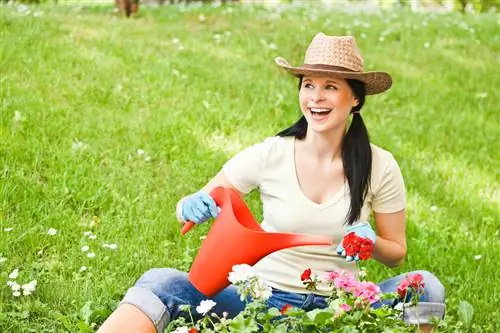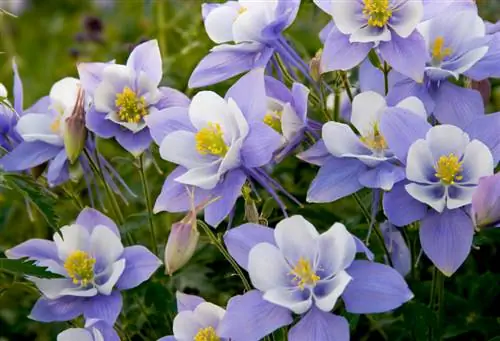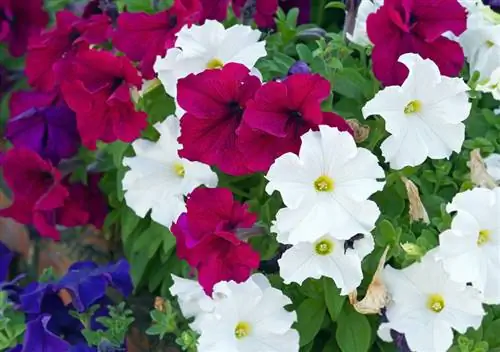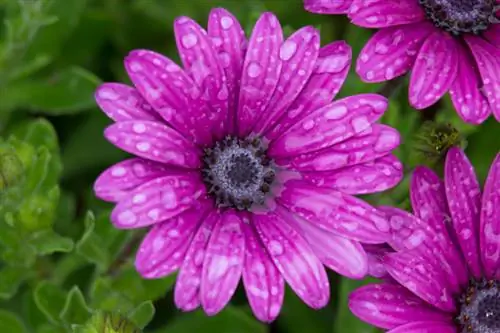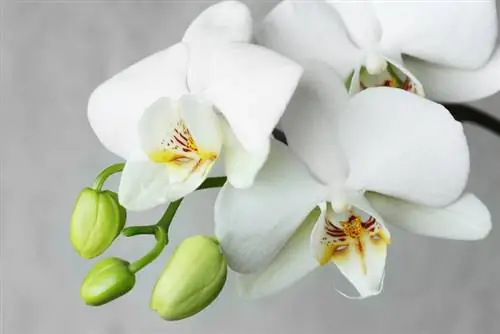- Author admin [email protected].
- Public 2023-12-16 16:46.
- Last modified 2025-06-01 06:02.
Strictly speaking, the balcony flowers usually referred to as “geraniums” are not actually such flowers, but rather pelargoniums - the botanist calls the cranesbills, which are also native to us, “geraniums”. Well, pelargoniums also belong to the cranesbill family, but - since they originally come from southern Africa - they have completely different needs than the cranesbill. This is how you properly care for the popular summer bloomers.

How do I care for geraniums properly?
To care for geraniums properly, you should water them regularly and evenly, provide them with flowering plant fertilizer weekly and remove dead shoots. Geraniums are not hardy and must overwinter in frost-free, cool rooms.
How often do you have to water geraniums?
Geraniums need a lot of water and should be kept slightly moist as evenly as possible. However, occasional drought does not harm the plants, in contrast to waterlogging. So ensure good drainage through the appropriate substrate and the correct layering in the planter. In addition, it is better to water more often and less than to rarely give the plants a lot of water at once.
When and with what should you fertilize geraniums?
The geraniums that bloom a lot are heavy feeders and should be supplied with a (liquid) fertilizer for flowering plants (€14.00 on Amazon) once a week. Although special geranium fertilizer is available commercially, it is not necessary to use it. Fertilization is carried out from the first shoots in April / May until around the beginning / middle of September. For home-grown geraniums, start fertilizing within six to eight weeks after germination.
Do you have to cut geraniums? If yes, when?
If you don't want to overwinter your geraniums, all you need to do is regularly cut off dead shoots. On the other hand, geraniums that are overwintered need to be cut back once a year. The plants should be trimmed vigorously before the first frost and then moved to winter quarters.
When is the best time to repot a geranium?
Repot your geraniums into a new planter with fresh substrate shortly before the first new shoots appear. It is best to complete this task around the end of February / March.
Which diseases/pests are particularly common in geraniums?
Geraniums are quite susceptible to the so-called geranium or pelargonium rust. This fungal disease causes yellow-brown spots to appear, especially on the undersides of the leaves. Gray rot (Botrytis), wilt or mildew are also quite common. Yellow leaves often indicate an iron deficiency. When it comes to pests, the main ones found on geraniums are mites, aphids and thrips.
The buds on my geranium are drying up - why is it?
If your geraniums develop buds but they don't open, there are various possible reasons:
- You are watering too much (waterlogging).
- You fertilize too much (root damage).
- You are watering too little.
- You fertilize too little.
Seemingly drying buds are not uncommon, especially in rainy summers.
What to do if the geranium doesn't want to bloom?
If the geranium does not want to bloom, it is often due to the abundant foliage. If the plant has too many leaves, the buds no longer get enough light - so you have to thin out the bushy plant a lot.
Are geraniums hardy?
Geraniums are not hardy here and should therefore be frost-free but cool over the winter.
Tip
It is also little known that geraniums do not necessarily need soil to overwinter.

